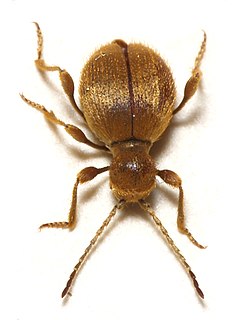
The Mygalomorphae, or mygalomorphs, are an infraorder of spiders. The name is derived from the Greek mygalē, meaning "shrew", plus morphē meaning form or shape. An older name for the group is Orthognatha, derived from the orientation of the fangs which point straight down and do not cross each other. In 1802, Charles Athanase Walckenaer separated mygalomorph spiders into a separate genus, Mygale, leaving all other spiders in Aranea.

Huntsman spiders, members of the family Sparassidae, are known by this name because of their speed and mode of hunting. They are also called giant crab spiders because of their size and appearance. Larger species sometimes are referred to as wood spiders, because of their preference for woody places. In southern Africa the genus Palystes are known as rain spiders or lizard-eating spiders. Commonly they are confused with baboon spiders from the Mygalomorphae infraorder, which are not closely related.

The Pholcidae are a family of araneomorph spiders. The family contains over 1,800 pholcids, including those commonly known as the marbled cellar spider , daddy long-legs spider, granddaddy long-legs spider, carpenter spider, daddy long-legger, vibrating spider, gyrating spider, long daddy, and skull spider. The family, first described by Carl Ludwig Koch in 1850, is divided into 94 genera.

The sac spiders of the family Clubionidae have a very confusing taxonomic history. Once, this family was a large catch-all taxon for a disparate collection of spiders, similar only in that they had eight eyes arranged in two rows and conical anterior spinnerets that touched, and were wandering predators that built silken retreats, or sacs, usually on plant terminals, between leaves, under bark, or under rocks. These are now recognized to include several families, some of which are more closely related to the three-clawed spiders, like lynx and wolf spiders, than to Clubionidae and related families.

Spider beetles make up the subfamily Ptininae, in the family Ptinidae. There are approximately 70 genera and 600 species in the subfamily, with about 12 genera and 70 species in North America north of Mexico.

Steatoda capensis is a spider originating from South Africa. Its common names include the black cobweb spider, brown house spider, cupboard spider and due to its similarities to the katipō spider it is commonly known as the false katipō in New Zealand. Common throughout Southern Africa, it has been introduced into other countries and is now present in Australia and throughout New Zealand. It is a small spider, usually an all-over shiny black it may have a small bright red, orange, or yellow patch near the tip of the abdomen along with a crescent shaped band near the front of the abdomen.
Andasta is a genus of ray spiders that was first described by Eugène Louis Simon in 1895.
Pleorotus was a monotypic genus of Seychelloise huntsman spiders containing the single species, Pleorotus braueri. It was first described by Eugène Louis Simon in 1898, and was endemic to the Seychelles. The description was based on a single male collected on Mahe Island in 1894, but none have been found in later collections, and it has been declared extinct.
Tecution is a genus of spiders from Saint Helena within the family Cheiracanthiidae. They were first described and named by Benoit in 1977. It was originally placed in the Clubionidae, but it was moved to Miturgidae in 1997, then to Cheiracanthiidae by Ramírez in 2014. The genus consists of three species.

Ostearius is a genus of dwarf spiders that was first described by J. E. Hull in 1911. As of May 2019 it contains only two species, both found in Spain, Turkey, Egypt, China, South Africa, and New Zealand: O. melanopygius and O. muticus.
Tetragnatha torrensis is a species of long-jawed orb weaving spiders of the family Tetragnathidae. It is endemic on the island of Santo Antão, Cape Verde. The species name torrensis refers to the place where it was found: Ribeira da Torre.
Theridion luteitarse is a species of spiders of the family Theridiidae. It is endemic on the island of Santo Antão, Cape Verde. The species was named and described by Günter E. W. Schmidt and Rolf Harald Krause in 1995.
Uloborus rufus is a species of spiders of the family Uloboridae. It is endemic in Cape Verde. The species was named and described by Günter E. W. Schmidt and Rolf Harald Krause in 1995.
Pellenes marionis is a species of jumping spiders. They are found in the island of Sal, Cape Verde. The species was first described by Joachim Schmidt and Otto Krause in 1994 as Bianor marionis. It was transferred to the genus Pellenes by D. V. Logunov in 2001.

Castianeira longipalpa is a species of true spider in the family Corinnidae. It is found in the United States as well as Canada. It is a type of ant-mimic sac spider, and has most often been observed along the east coast of North America.
Porrhomma convexum is a species of sheetweb spider in the family Linyphiidae. It is found in Canada, Europe, Caucasus, and Russia (European).

Gea heptagon is a species of orb weaver spiders in the family Araneidae. It is found in PacificIslands, Australia, and a range from has been introduced into United States to Argentina.

Coras lamellosus is a species of funnel weaver in the family of spiders known as Agelenidae. It is found in the United States.

Dolomedes albineus, the white-banded fishing spider, is a species of nursery web spider in the family Pisauridae. It is found in the United States. Like most Dolomedes, this spider tends to hunt at or in streams and ponds. It has special hairs that repel water, allowing it to walk on water, and trap an air bubble on its abdomen to dive and swim, so that it can hunt tadpoles and aquatic invertebrates.










